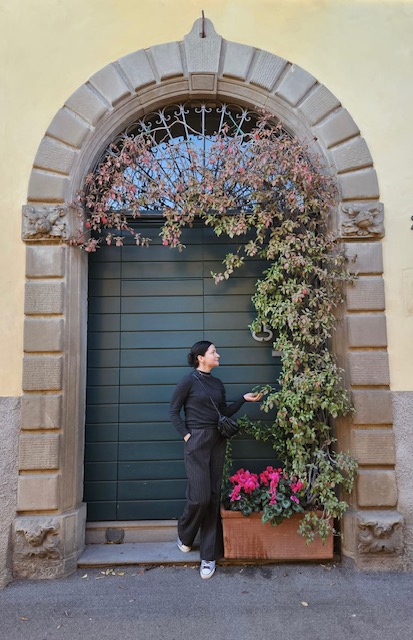Do you live in a big city or, perhaps, in a small town? Do you like walking through the city center or enjoy the landscapes from your car window? Most likely, the place you live in is green and diverse. However, unfortunately, not all cities are like that. Since traffic islands and parking lots contain rich plant communities, they should be better integrated into the unity of all urban green spaces, writes Dr. Oksana Skaldina.
Urban life has many advantages including better health, work, and education possibilities. However, nature is often left behind.
“Our World in Data” states that the percentage of the global population living in urban areas has already reached 56% in 2021. The urbanization trend is ongoing and, according to the United Nations projections, by 2050 we will have around 68% of people living in cities worldwide. But is our aim of making cities green and sustainable up to speed with the urbanization trend?
To maintain balanced urban life in 20 or 30 years we need to think now about what kind of quick, simple, and efficient solutions can be undertaken to make urban areas more sustainable. Consequently, urban ecology (a relatively young discipline with a history of about 40 years) is nowadays more relevant than ever.
Overlooked wild plants
In cities, the unity of all urban green spaces (parks, meadows, lawns, flower beds, balcony greeneries, etc.) forms a diverse network known as urban green infrastructure (UGI). Some elements of UGI are valued more than the others. Many inhabitants pay attention to exotic vegetation in parks and city squares, but do we notice beautiful wild plants at the road edges? Floral communities associated with traffic-related green spaces are rarely considered valuable elements of urban green infrastructure. But is that a mistake? Could roadside vegetation assist in improving environmental quality in cities?



The recent paper written by our team focuses on answering this question. Together with my colleagues MSc. Annika Nylund and Dr. Satu Ramula from the University of Turku and University of Eastern Finland, we researched on the diversity of floral communities in traffic-related urban green spaces. We studied vegetation on traffic islands, parking lots, and road verges in 90 urban and suburban locations in three Finnish cities: Helsinki, Tampere, and Turku. The survey was conducted in the year 2022 during July-August – time when biodiversity of flora and fauna in Finland reaches its season maximum. Our main goal was to assess if traffic-related green spaces in Finland possess species-rich floral communities and can assist urban ecological restoration – converting degraded areas into functionally diverse ecosystems.
After several weeks of intense field-work campaign, we came back filled with high expectations. Even in highly fragmented and polluted urban landscapes, we saw biologically diverse and rich plant communities. Overall, our data revealed 167 vascular plant species and 93 insect-pollinated plant species that were flowering during the survey – so happily, our expectations were met.
Traffic islands, biodiversity islands
Do you know what are the most common wild flowering plants in traffic-related areas in Finland? According to our results, they are yarrow (Achillea millefolium) and autumn hawkbit (Leontodon autumnalis) which occurred in around 70% of the sites. Unfortunately, we found plenty of urban voids and vacant lots free from vegetation or cut grass in many places. This raised debates (again and again) on the ecological justifications for grass mowing and the necessity for the vegetation presence in cities.
But what about urban and suburban areas, is there a big difference in vegetation? According to our research, in urban locations, there were fewer species and plant communities, while suburban areas were a bit more diverse. Interestingly, both urban and suburban areas were rich in the flowering plants during the survey. When it’s time to bloom, nature blooms, and the location doesn’t matter! Surprisingly, traffic islands – the most fragmented, isolated, and polluted urban green spaces – turned out to be the richest for biodiversity of flowering plants. This finding clearly states that those areas deserve our attention!

During our fieldwork, we met many citizens who asked us about work we are doing. One time, we discussed a vegetation on the parking lots and its value for the people right at the place with citizens. If a person is working at the office 8 hours during five days per week, the only option to enjoy wild nature will be vegetation at the parking lots. This is the point where socioecological factors matter! Since traffic islands and parking lots contain rich plant communities, they should be better integrated into UGI.
Simple solutions into action
What are our conclusions so far? At least we can say this: traffic-related urban green spaces are great for biodiversity!
However, management intensity in terms of grass cuts should be ecologically justified. An increase in the number of insect-pollinated plant species in urban traffic-related green spaces might help to improve environmental quality in cities in terms of increasing pollinator biodiversity and reducing pollution. Urban environments are quite fragmented, and sometimes pollinators must travel long distances for food. Improving the ecological sustainability in traffic-related urban green spaces might help to enhance urban green corridors.
I really hope that our work will assist better integration of traffic-related green spaces in the sustainable network of urban greeneries. With such simple and chip nature-based solutions, cities could become greener and more diverse!
Once again, I am warmly thankful for Maj and Tor Nessling Foundation for supporting the project idea as well as to Societas pro Fauna et Flora Fennica and Kuopion Naturalists Society for supporting Annika Nylund’s master thesis performed during the project. The story continues, as Annika Nylund was, by our project, encouraged to continue doing PhD.

About Oksana Skaldina:
The writer works as a postdoctoral researcher at the University of Eastern Finland. Her postdoctoral research project is entitled “Less atmospheric carbon, more pollinators: rethinking the restoration capacity of artificial greeneries”. It is dedicated to ecological restoration of city landscapes and funded by Maj and Tor Nessling Foundation.

